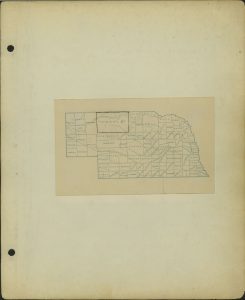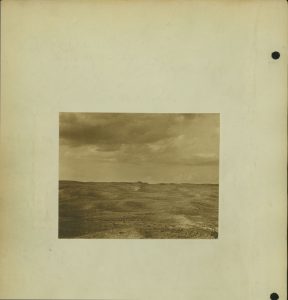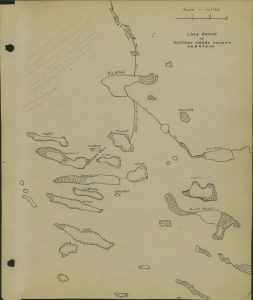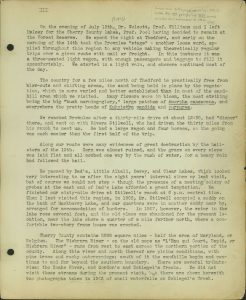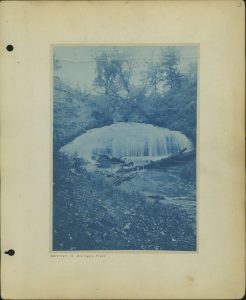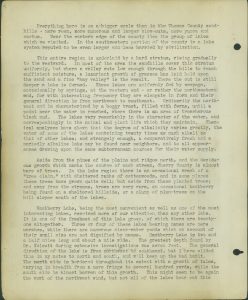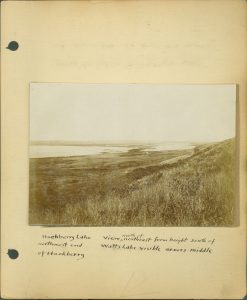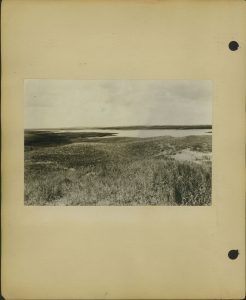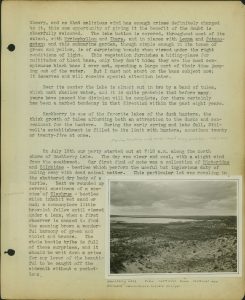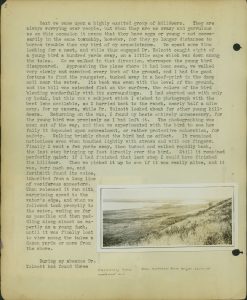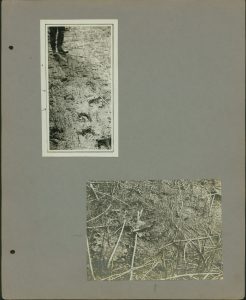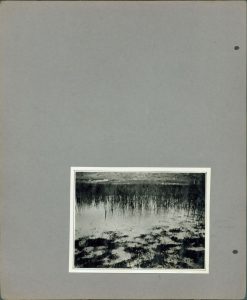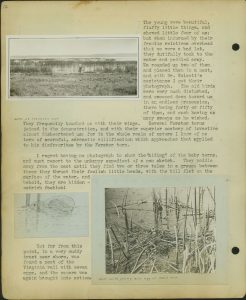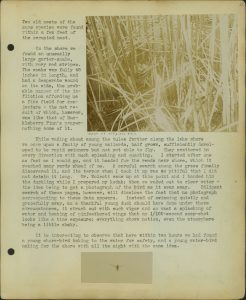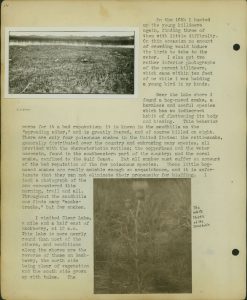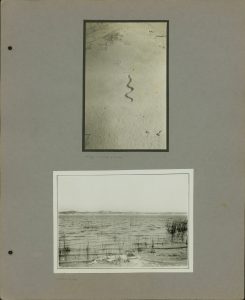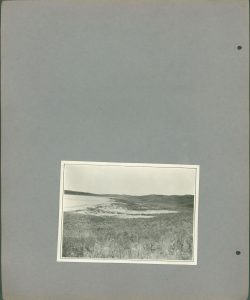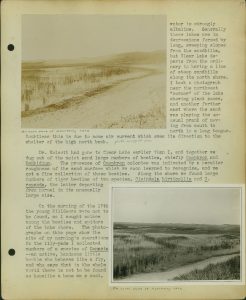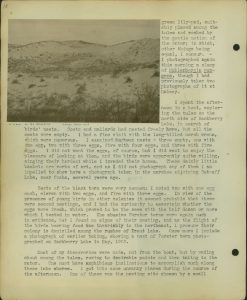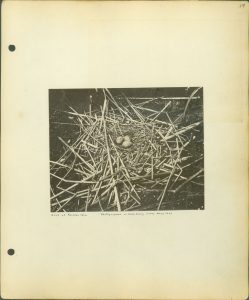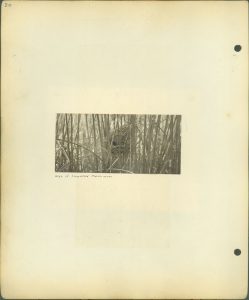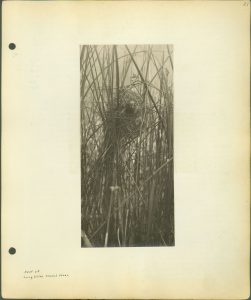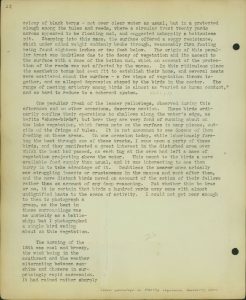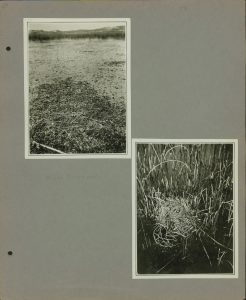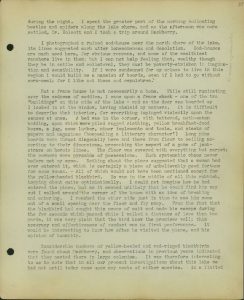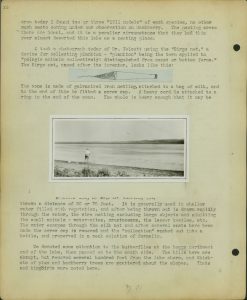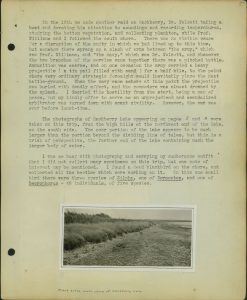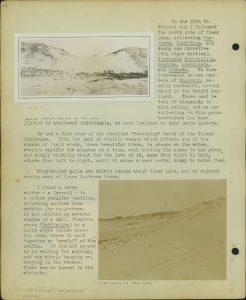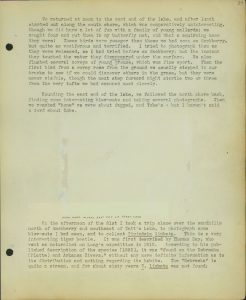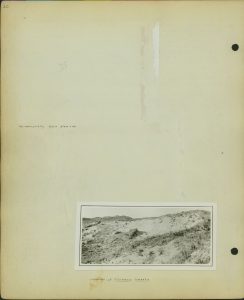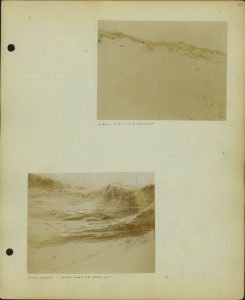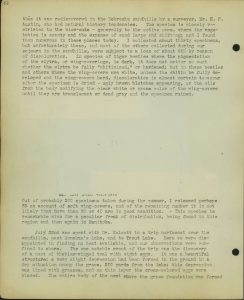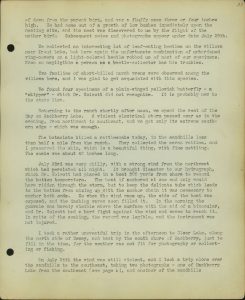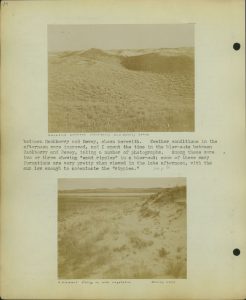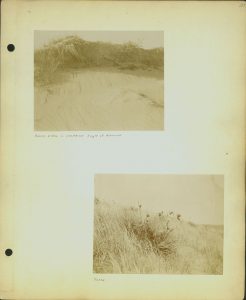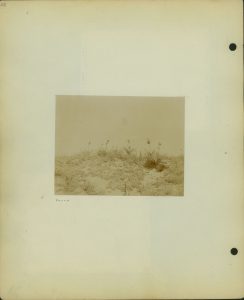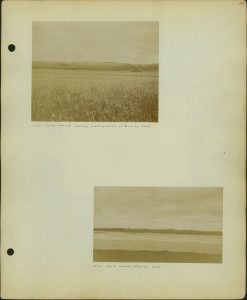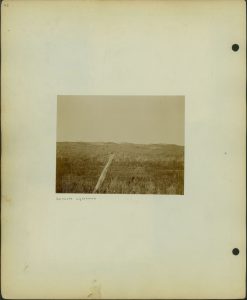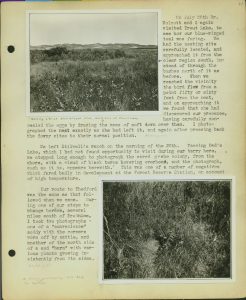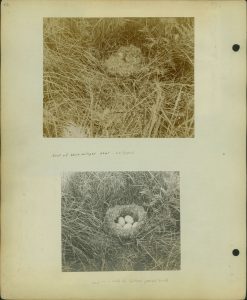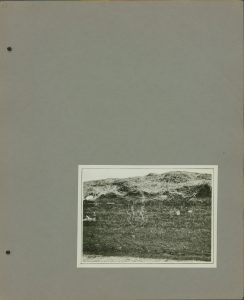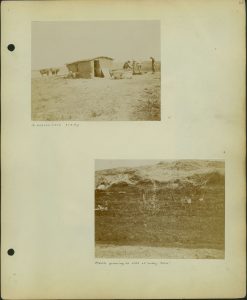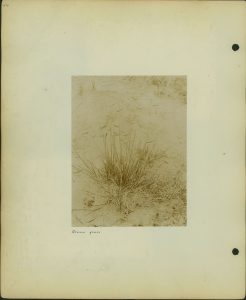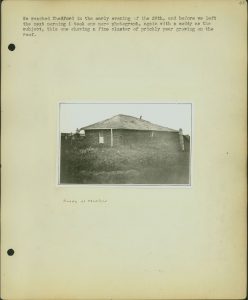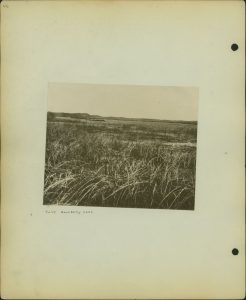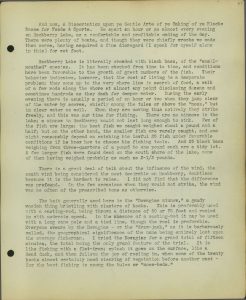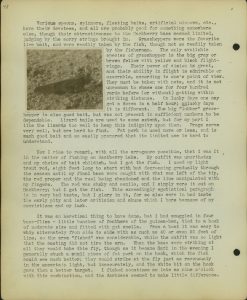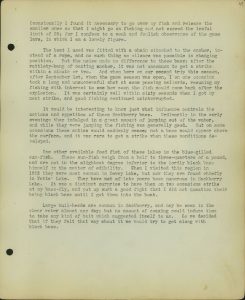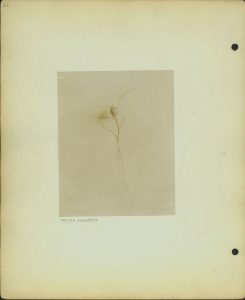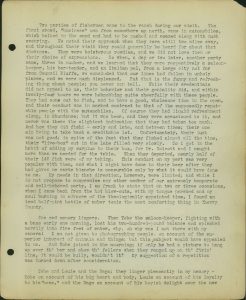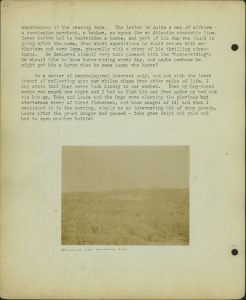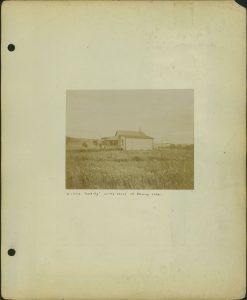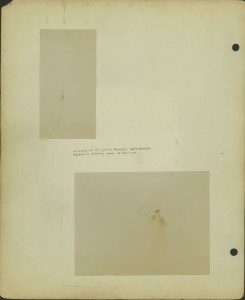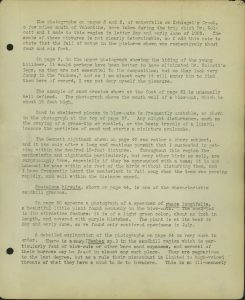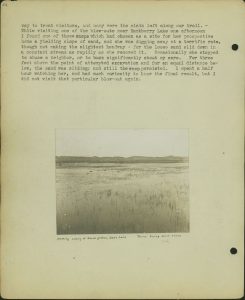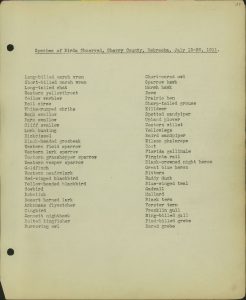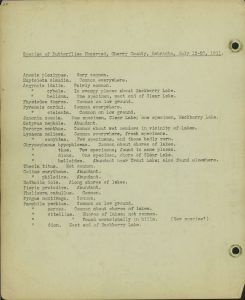Great Nebraska
Naturalists and ScientistsFrank H. Shoemaker
Cherry County, July 13-July 26, 1911
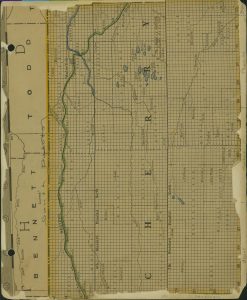
cover
map
photograph
photograph
III group, of VII areas visible and recorded in 1911. FHS
On the evening of July 13th 1911, Dr. Wolcott, Prof. Williams and I left Cover and title
page missing. This is the No. III group, of VII areas visited and recorded in 1911.
FHS Halsey for the Cherry County lakes, Prof. Pool having decided to remain at the Forest Reserve.
We spent the night at Thedford, and early on the morning of the 14th took the Brownlee “stage”
— another loose word, applied throughout this region to any vehicle making theoretically regular trips over a given route with mail or freight. In this instance it was a three-seated light wagon, with enough passengers and baggage to fill it uncomfortably. We started in a light rain, and showers continued most of the day.
The country for a few miles north of Thedford is practically free from blow-outs and shifting areas, the sand being held in place by the vegetation, which is more varied and better established than in most of the sandhill area which we visited. Many flowers were in bloom, the
most striking being the big “bush morning—glory,” large patches of Amorpha canescens, and everywhere the pretty heads of Kuhnisteracandida and purpurea.
We reached Brownlee after a thirty-mile drive at about 12:30, had “dinner” there, and went on with Rivers Stilwel, who had driven the thirty miles from his ranch to meet us. He had a large wagon and four horses, so the going was much easier than the first half of the trip.
Along our route were many evidences of great destruction by the hailstorm of the 12th. Corn
was almost ruined, and the grass on every slope was laid flat and all combed one way by the
rush of water, for a heavy rain had followed the hail.
We passed by Dad’s, Little Alkali, Dewey, and Clear Lakes, which looked very interesting to
me after the eight years’ interval since my last visit, but of course we could not stop — though the presence of a nesting colony of grebes at the east end of Dad’s Lake afforded a great temptation. We finished our sixty-mile drive at Stilwel’s ranch at 6 p.m. central time. When I last visited this region, in 1903, Mr. Stilwel occupied a soddy on the bank of Hackberry Lake, and our quarters were in another soddy near by arranged for accommodation of hunters. In 1907, however, the water in the lake rose several feet, and the old place was abandoned for the present location, near the lake shore a quarter of a mile farther north, where a comfortable two-story frame house was erected.
Cherry County contains 5668 square miles — half the area of Maryland, or Belgium. The Niobrara River — on the old maps as “L’Eau qui Court, Rapid, or Niobrara River” — runs from west to east across the northern portion of the county. Along this river and north thereof are plains conditions, with pine trees and rocky outcroppings; south of it the sandhills begin and continue to and far beyond the southern boundary. There are several tributaries; the Snake River, and Gordon’s and Schlegel’s [sic] Creeks. We did not visit these streams during the present visit, but there are shown herewith two photographs taken in 1903 of small waterfalls on Schlegel’s [sic] Creek.
2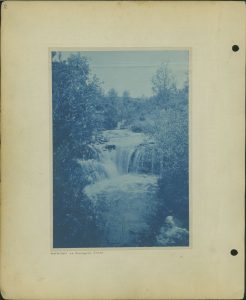
Watefall on Schlegel’s [sic] Creek
Watefall on Schlegel’s [sic] Creek
Everything here is on a bigger scale than in the Thomas County sand-hills — more room, more numerous and larger blow-outs, more yucca and cactus. Near the eastern edge of the county lies the group of lakes which we visited. In the southwestern portion of the county is a lake system reputed to be even larger and less harried by civilization.
This entire region is underlaid by a hard stratum, rising gradually to the westward. In most of the area the sandhills cover this stratum uniformly, but where a valley cuts low enough through the hills to reach sufficient moisture, a luxuriant growth of grasses has laid hold upon the sand and a fine “hay valley” is the result. Where the cut is still deeper a lake is formed. These lakes are uniformly fed by seepage, occasionally by springs, at the western end — or rather the northwestern end, for with interesting frequency they are elongate in form and their general directions in from northwest to southeast. Ordinarily the northwest end is characterized by a boggy tract, filled with ferns, until a point near the water is reached, where there is an area of treacherous black mud. The lakes vary remarkably in the character of the water, and correspondingly in the animal and plant life which they maintain. Chemical analyses have shown that the degree of alkalinity varies greatly, the water of some
of the lakes containing twenty times as much alkali as that of other lakes; and strangely enough, a
comparatively fresh and a markedly alkaline lake may be found near neighbors, and to all appearances drawing upon the same subterranean sources for their water supply.
Aside from the pines of the plains and ridges north, and the deciduous growth, which marks the course of each stream, Cherry County is almost bare of trees. In the lake region there is an occasional wreck of a “tree claim,” with shattered ranks of cottonwoods, and in
some places these trees have grown quite well; but aside from these planted trees; and away from
the streams, trees are very rare, an occasional hackberry being found on a sheltered hillside,
or a clump of plum-trees on the hill slopes south of the lakes.
Hackberry Lake, being the most convenient as well as one of the most interesting lakes, received more of our attention than any other lake. It is one of the freshest of this lake group, of which there are twenty-one altogether. Three of four of these lakes bearing names are mere marshes, while there are numerous clear-water ponds which on account of their small size are not dignified by names. Hackberry Lake is two and a half miles long and about a mile wide. The greatest depth found by Dr. Wolcott during extensive investigations was seven feet. The general direction of the lake is from northwest to southeast, but I have elided this in my notes to north and south, and will keep up the bad habit. The north side is bordered throughout its extent with a growth of tules, [reeds] varying in breadth from a mere fringe to several hundred yards, while the south side is almost barren of this growth. This might seem to be again the work of the northwest wind, but not all of the lakes bear out this
Hackberry Lake northwest end of Hackberry View north of northeast from height south of Watt’s Lake visible across middle
[No caption}
Hackberry Lake View northwest from southeast and Stillwell’s ranch house visible on right
theory, and as that malicious wind has enough crimes definitely charged to it, this one opportunity of giving it the benefit of the doubt is cheerfully welcomed. The lake bottom is covered, throughout most of its extent, with Myriophyllum and Chara, and in places Lemna and Potamo-geton; and this submarine garden, though simple enough in its tones of green and yellow, is of surprising beauty when viewed under the right conditions of light. This vegetation furnishes a hiding-place for multitudes of black bass, only they don’t hide; they are the most con—spicuous black bass I ever met, spending a large part of their time jumping out of the water. But I must not start on the bass subject now; it deserves and will receive special attention later.
Near its center the lake is almost cut in two by a band of tules, which mark shallow water, and it is quite probable that before many years have passed the division will be complete, for there certainly has been a marked tendency in that direction within the past eight years.
Hackberry is one of the favorite lakes of the duck hunters, the thick growth of tules affording both an attraction to the ducks and concealment for the hunters. During the early spring and late fall, Stilwel’s establishment is filled to its limit with hunters, sometimes
twenty or twenty-five at once.
On July 15th our party started out at 7:15 a.m. along the north shore of Hackberry Lake. The day was clear and cool, with a slight wind from the southwest. Our first find of note was a
collection of Histeridae and Silphidae — beetles which perform the useful but inglorious duty of making away with dead animal matter. This particular lot was reveling in the shattered dry body of a turtle. Next we rounded up several specimens of a species *
of Elaphrus — beetles which inhabit wet sand or mud; a commonplace little brownish fellow until viewed under a lens, when a first observer is amazed to find the seeming brown a wonderful harmony of green and violet and bronze. The whole beetle tribe is full of these surprises, and it should be writ down a crime for any lover of the beautiful to be caught off the sidewalk without a pocket-lens.
Hackberry Lake View northeast from height south of northwest end
Next we came upon a highly excited group of killdeers. They are always worrying over people, but when they are as crazy and garrulous as on this occasion it means the they have eggs or young — not necessarily in the same township, however, for they go longer distances to borrow trouble than any bird of my acquaintance. We spent some time looking for a nest, and while thus engaged Dr. Wolcott caught sight of a young bird a hundred yards away, on a little cape which ran down among the tules. So we walked in that direction, whereupon the young bird disappeared. Approaching the place where it had been seen, we walked very slowly and examined every inch of the ground, and I had the good fortune to find the youngster, tucked away in a hoof-print in the damp soil near the water. Its back was even with the level of the ground, and its bill was extended flat on the surface, the colors of the bird blending wonderfully with its surroundings. I had started out with only my Kodak [camera], but this was a subject which I wished to photograph with the best lens available, so I hurried back to the ranch, nearly half a mile away, for my camera, while Dr. Wolcott looked about for other young killdeers. Returning on the run, I found my haste entirely unnecessary, for the young bird was precisely as I had left it. The photographing was soon out of the way, and then we experimented with the bird to see how fully it depended upon concealment, or rather protective coloration, for safety. Walking briskly about the bird had no effect. It remained motionless even when touched lightly with straws and with our fingers. Finally I went a few yards away, then turned and walked rapidly back, the last step bringing my foot directly over the bird. Still it remained perfectly quiet; if I had finished that last step I would have finished the killdeer. Then we
picked it up to see if it was really alive, and it was, very much so, and forthwith found its voice, inherited from a long line of vociferous ancestors. When released it ran with surprising speed to the water’s edge, and when we followed took promptly to the water, wading as far as possible and then paddling along almost as expertly as a young duck, until it was finally lost to view among the tules a dozen yards or more from the shore.
During my absence Dr. Wolcott had found three
No caption
11
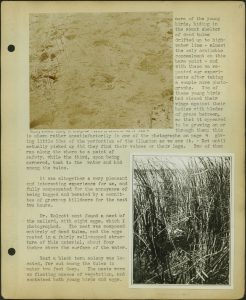
Young killdeer hiding in hoofprint — same as shown on top of page 9.
Nest of mallard
more of the young birds, hiding in the scant shelter of dead tules drifted up to high water line — almost the only available concealment on this bare point – and with these we repeated our experiments after taking a couple more photographs. Two of these young birds had closed their wings against their bodies with blades of grass between, so that is appeared to be growing on or through them; this is shown rather unsatisfactorily in one of the photographs on page 9 giving little idea of the perfection of the illusion as we saw it. — Not until actually picked up did they find their voices or their legs. Two of them ran along the shore to a point of safety, while the third, upon being cornered, took to the water and hid among the tules.
It was altogether a very pleasant and interesting experience for us, and fully compensated for the annoyance of being tagged and berated by a committee of grown-up killdeers for the next two hours.
Dr. Wolcott next found a nest of the mallard, with eight eggs, which I photographed. The nest was composed entirely of dead tules, and the eggs rested in a fairly well-cupped structure of this material, about four inches above the surface of the water.
Next a black tern colony was located, far out among the tules in water two feet deep. The nests were on floating masses of vegetation, and contained both young birds and eggs.
Site of mallard’s nest
Nest with young and egg of black tern
The young were beautiful, fluffy little things, and showed little fear of us; but when informed by their frantic relatives overhead that we were a bad lot, they dutifully took to the water and paddled away. We rounded up two of them and placed them in a nest, and with Dr. Wolcott’s assistance I got their photograph. The old birds were very much disturbed, and
swooped down toward us in an endless procession, there being forty and fifty of them, and each
having as many swoops as he wished. They frequently touched us with their wings. Several Forster terns joined in the demonstration, and with their superior mastery of invective almost disheartened us; for in the whole realm of nature I know of no term of scornful, sarcastic vilification which approaches that applied to his disfavorites by the Forster tern.
I regret having no photograph to show the “hiding” of the baby terns, and must resort to the unhappy expedient of a pen sketch. They paddle away from the nest until they find two or three tules in a group; between these they thrust their foolish little heads, with the bill flat on the surface of the water, and behold, they are hidden — ostrich fashion!
Not far from this point, in a very muddy tract near shore, was found a nest of the Virginia rail with seven eggs, and the camera was again brought into action.
Nest of Virginia rail
Two old nests of the same species were found within a few feet of the occupied nest.
On the shore we found an unusually large garter-snake, with very red stripes. The snake was fully 48 inches in length, and had a desperate wound on its side, the probable manner of its infliction affording us a fine field for conjecture — the net result of which, however, was like that of Huckleberry Finn’s prayer: nothing come of it.
While wading about among the tules farther along the lake shore we came upon a family of young mallards, half grown, sufficiently developed to be rapid swimmers but not yet able to fly. They scattered in every direction with much splashing and quacking. I started after one as fast as I could go, and it headed for the reeds near shore, which it reaches many yards ahead of me. A careful search among the grass finally discovered it, and its terror when I took it up was so pitiful that I did not detain it long. Dr. Wolcott came up at this point and I handed him the duckling while I prepared my kodak (sic); then we waded out to clear water — the idea being to get a photograph of the bird as it swam away. Diligent search of these pages, however, will disclose the fact that no photograph corresponding to these data appears. Instead of swimming quietly and gracefully away, as a thankful young duck should have done under these circumstances, it struck out with such vigor and so vast a splashing of water and beating of pinfeathered wings that my 1/100-second snap-shot looks like a time exposure; everything shows motion, even the atmosphere being a little shaky.
It is interesting to observe that here within two hours we had found a young shore-bird taking to the water for safety, and a young water-bird making for the shore with all its might with the same idea.
Killdeer
The white thistle of the Sandhills
On the 16th I hunted up the young killdeers again, finding three of them with little difficulty. On this occasion no amount of crowding would induce the birds to take to the water. I also got two rather inferior photographs of the parent killdeers, which came within ten feet of me while I was holding a young bird in my hands.
Near the lake shore I found a hob-nosed snake, a harmless and useful species which has an indiscreet habit of flattening its body and hissing. This behavior earns for it a bad reputation; it is known in the sandhills as the “spreading adder,” and is greatly feared, and of course killed on sight. There are only four poisonous snakes in the United States: the rattlesnake, generally distributed over the county and embracing many species, all provided with the characteristic rattles; the copperhead and the water moccasin, found in the southeastern part of the country; and the coral snake, confined to the Gulf coast. But all snakes must suffer on account of the bad reputation of the few poisonous species. These little hognosed snakes are really amiable enough on acquaintance, and it is unfortunate that they cannot eliminate their propensity for bluffing. I took a photograph of the one encountered this morning, trail and all. Throughout the sandhills one finds many “snake-tracks,” but few snakes.
I visited Clear Lake, a mile and a half east of Hackberry, at 10 a.m. This lake is more nearly round than most of the others, and conditions along its shores are the reverse of those on Hackberry, the north side being clear of vegetation and the south side grown up with tules. The
Hog-nosed snake
Clear Lake
Clear Lake
On north shore of Hackberry Lake
On north shore of Hackberry Lake
water is strongly alkaline. Generally these lakes are in depressions formed by long, sweeping
slopes from the sandhills, but Clear Lake departs from the ordinary in having a line of steep
sandhills along its north shore. I took a photograph near the northwest “corner” of the lake
showing plant zones, and another farther east where the sand was playing the unusual prank of
moving from south to north in a long tongue. Doubtless this is due to some air current which owes its direction to the shelter of the high north bank.
Dr. Wolcott had gone to Clear Lake earlier than I, and together we dug out of the moist sand large numbers of beetles, chiefly Omophron and Bembidium. The presence of Omophron colonies was indicated by a peculiar roughness of the sand surface which we soon learned to recognize, and we got a fine collection of these beetles. Along the shore we found large numbers of tiger beetles of two species, Cicindela hirticollis and C.
repanda, the latter departing from normal in its unusually large size.
On the morning of the 17th the young killdeer were not to be found, so I sought solace among the beetles and spiders of the lake shore. The photographs on this page show the site of morning’s operations. On the lily-pads I collected numbers of a species of Donacia — — an active, handsome little beetle who behaves like a fly, and who says that in the whole world there is not to be
found so homelike a home as a cool,
A view in the Sandhills Large blow-out
green lily-pad, suitably placed among the tules and rocked by the gentle motion of the water; in which, other things being equal, I concur. — I photographed again this morning a clump of Muhlenbergia pungens, though I had previously taken two photographs of it at Halsey.
I spent the afternoon in a boat, exploring the tules on the north side of Hackberry Lake, in search of birds’ nests. Coots and mallards had nested freely here, but all the nests were empty. I had a fine visit with the long-billed marsh wrens, which were numerous. I examined fourteen nests — three empty, one with one egg, two with three eggs, five with four eggs, and three with five eggs. I did not want the eggs, of course, but I did want to enjoy the pleasure of looking at them, and the birds were apparently quite willing, singing their hardest while I invaded their homes. These dainty little baskets are works of art, and as I did not photograph taken in the marshes adjoining Cut-off Lake, near Omaha, several years ago.
Nests of the black tern were very common; I noted two with one egg each, eleven with two eggs, and five with three eggs. In view of the presence of young birds in other colonies it seemed probable that these were second nestings, and I had the curiosity to ascertain whether the eggs were fresh, which proved to be the case with the half dozen or more which I tested in water. The abusive Forster terns were again much in evidence, but I found no signs of their nesting, and as the flight of the birds bearing food was invariably to the northeast, I presume their colony is domiciled among the rushes of Trout Lake. Once more I include a photograph of earlier taking, showing a nest of Forester tern photographed on Hackberry Lake in May, 1903.
Most of my discoveries were made, not from the boat, but by wading about among the tules, rowing to desirable points and then taking to the water. One must have amphibious inclinations to accomplish much along these lake shores. I got into some uncanny place during the course of the afternoon. One of these was the nesting site chosen by a small
Nest of forster tern Photographed on Hackberry Lake, May 1903
Nest of Long-billed marsh wren
Nest of Long-billed Marsh Wren
colony of black terns — not over clear water as usual, but in a protected slough among the tules and reeds, where a circular tract twenty yards across appeared to be floating mud, and suggested unhappily a bottomless pit. Stepping into this mass, the surface offered a soggy resistance, which under added weight suddenly broke through, reasonably firm footing being found eighteen inches or two feet below. The origin of this peculiar tract was doubtless dude to the decay of vegetation and its ascent to the surface with a mass of the bottom mud, which on account of the protection of the reeds was not affected by the waves. In this ridiculous place the aesthetic terns had seen fit to establish their home, and several nests were scattered about the surface — a few wisps of vegetation thrown together, and
an alleged depression shaped by the birds in the center. The range of nesting artistry among birds
is almost as “varied as human conduct,” and as hard to reduce to a coherent system.
One peculiar freak of the lesser yellowlegs, observed during this afternoon and on other occasions, deserves mention. These birds ordinarily confine their operations to shallows along the water’s edge, as befits “shore-birds”; but here they are very fond of running
about on the lake vegetation, which forms mats on the surface in many places, outside of the fringe
of tules. It is not uncommon to see dozens of them feeding on these areas. On one occasion today,
while laboriously forcing one of these tracts, I came upon a party of these birds, and they
manifested a great interest in the disturbed area over which the boat had passed, as each tug at the oars had left a mass of vegetation projecting above the water. This meant to the birds a more available food supply than usual, and it was interesting to see them hurry in to take advantage of it. Doubtless the nearer ones actually saw struggling insects or crustaceans in the masses and went after them, and the more distant birds moved on account of the action of their fellows rather than on account of any deep reasoning. But whether this be true or no, it is certain that birds a hundred yards away came with almost undignified haste to the scene of activity. I could not get near enough group, as the boat in these surroundings was unwieldy as a battleship; but I photographed a single bird wading about on this vegetation.
The morning of the 18th was cool and breezy, the wind being in the southwest and weather alternating between sunshine and showers in surprisingly rapid succession. It had rained rather sharply
Black tern’s nests
during the night. I spent the greater part of the morning collecting beetles and spiders along the lake shore, and as the afternoon was more settled, Dr. Wolcott and I took a trip around Hackberry.
I photographed a ruined sod-house near north shore of the lake, its lines suggested such utter lonesomeness and desolation. Sod—houses are much used here, for obvious reasons, and some of the wealthiest ranchers live in them; but I can not help feeling that, wealthy though they be in cattle and collateral, they must be poverty-stricken in imagination and sensibility. If I were condemned for my crimes to live in this region I would build me a mansion of boards, even if I had to go without corn-meal; for I like not these sod sepulchers.*
But a frame house is not necessarily a home. While still ruminating over the sadness of soddies, I came upon a frame shack—one of the two “buildings” on this side of the lake — and as the door was boarded up I looked in at the in at the window, having mislaid my manners. It is difficult to describe that interior, for everything impinged violently upon the senses at once. A bed was in the corner, with tattered, moth-eaten bedding, upon which were piled ragged clothing, yellow breakfast-food boxes, a jug, some lumber, minor implements and tools, and stacks of papers and magazines (bespeaking a litterary character?). Long pine boards were thrust diagonally here and there from floor to ceiling according to their dimensions, presenting the aspect of a game of jackstraws on heroic lines. The floor was covered with everything but carpet; the corners were pyramids of possessions. Such systematic chaos never before met my eyes. Nothing about the place
suggested that woman had ever entered it, which is certainly a piece of unbelievably good fortune
for some woman. — All of which would not have been mentioned except for the yellow-headed blackbird. He was in the middle of all this rubbish, hopping about quite optimistically. I could not imagine how he had entered the place, but as it seemed unlikely that he could find his way out I walked around the corner of the house with an idea of breaking and entering. I reached the other side just in time to see him come out of a small opening near the floor and fly away. From the fact that the blackbird had sought this means of exit and made his escape during the few seconds which passed while I walked a distance of less than ten yards, it was very plain that the bird knew the premises well; this accuracy and effectiveness of conduct was not first performance. It would be interesting to know how often he visited the place, and his opinion of humanity.
Considerable numbers of yellow-headed and red-winged blackbirds were found about Hackberry, and observations in previous years indicated that they nested there in large colonies. It was
therefore interesting to us to note that in all our present investigations about this lake we
had not until today come upon any nests of either species. In a limited
Black tern’s nests
[handdrawn image of birge net]
area today I found two or three “1911 models” of each species, no other such nests coming under our observation on Hackberry. The nesting areas there are ideal, and it is a peculiar circumstance that they had this year almost deserted this lake as a nesting place.
I took a photograph today of Dr. Wolcott using the “Birge net,” a device for collecting plankton — “plankton” being the term applied to “pelagic animals collectively: distinguished from coast or bottom forms.” The Birge net, named after its inventor, looks like this:
The cone is made of galvanized iron netting, attached to a bag of silk, and to the end of this fitted a screw cap. A heavy cord is attached to a ring in the end of the cone. The whole is heavy enough that it may be
thrown a distance of 50 or 75 feet. It is generally used in shallow water filled with vegetation, and after being thrown out is drawn rapidly through the water, the wire netting excluding large objects and admitting the small animals — water-mites, crustaceans, the lesser beetles, etc. The water escapes through the silk net and after several casts have been made the screw cap is removed and the “collection” washed out into a bottle, and preserved in a weak solution of formalin.
We devoted some attention to the butterflies at the boggy northwest end of the lake, then passed on to the south side. The hills here are abrupt, but removed several hundred feet from the lake shore, and thickets of plum and hackberry trees are scattered about the slopes. Chats and kingbirds were noted here.
Dr. Wolcott using his Birge net, Hackberry Lake
On the 19th we made another raid on Hackberry, Dr. Wolcott taking a boat and devoting his attention to soundings and recording temperatures, studying the bottom vegetation,
and collecting plankton, while Prof. Williams and I followed the south shore. There was no visible cause for a disruption of the amity in which we had lived up to this time, but somehow there sprang up a clash of arms between “the army,” which was Prof. Williams, and “the navy,” which was Dr. Wolcott, and whenever the two branches of the service came together there was pitched battle. Ammunition was scarce, and on one occasion the army carried a heavy projectile (a tin pail filled with sand) for a half mile, to the point where very ordinary strategic foresight would inevitably place the next battle-ground. When the navy came ashore at this point the projectile was hurled with deadly effect, and the commodore was almost drowned by the splash. I decried this hostility from the start, being a man of peace, but kindly offer to serve as an unprejudiced and scandalized arbitrator was turned down with scant civility. However, the war was over before lunch-time.
The photographs of Hackberry Lake appearing on pages 5 and 8 were taken on this trip, from the high hills at the northwest end of the lake, on the south side. The near portion of the lake appears to be much larger than the portion beyond the dividing line of tules, but this is a trick of perspective, the
farther end of the lake containing much the larger body of water.
I was so busy with photography and carrying my cumbersome outfit that I did not collect many
specimens on this trip, but one note of interest may be mentioned. I found a dead blackbird on
the shore, and collected all the beetles which working on it. On this one small bird there were
three species of Silpha, one of Dermestes, and one of Necrophorus, — 48
individuals, of five species.
Plant zones, north shore of Hackberry Lake
Atypical blowout east end of Clear Lake
On the 20th Dr. Wolcott and I followed the north side of Clear Lake, collecting Omophron, Bembidium, and among our favorites (the tiger beetles), Cicindela hirticollis, repanda, punctulata, and limbata. We were interested to see numbers of Omophron, usually nocturnal, moving about in the bright sunlight. There must be tens of thousands in this colony, and as our collecting in this genus heretofore has been limited to scattered individuals, we were inclined to take large numbers.
We had a fine view of the perculiar “revolving” habit of the Wilson phalarope. With the lack of visible reason which affords one of the charms of field study, these beautiful birds, in groups on the water, revolve rapidly for minutes at a time, each holding his place in the group and simply whirling about for the love of it, some from the right to left, others from left to right, until it makes a mere mortal dizzy to watch them.
Ring-billed gulls are fairly common about Clear Lake, and we enjoyed seeing many of these
handsome birds.
I found a large spider—a lycosid—in a rather peculiar position, affording another nice problem for conjecture. It had climbed up several stalks of a tall, flexible grass (Redfieldia) to a point eight inches above the sand, where it held together an “armful” of the stalks. It did not appear to be waiting for anybody, and was simply hanging on, swaying in the breeze. There was no tunnel in the vicinity.
North shore of Clear Lake
We returned at noon to the west end of the lake, and after lunch started out along the south
shore, which was comparatively uninteresting, though we did have a lot of fun with a family of
young mallards; we caught four and put them in my butterfly net, and what a squirming mess they
were! These birds were younger than those we had seen on Hackberry, but quite as vociferous and
terrified. I tried to photograph them as they were released, as I had tried before on Hackberry; but the instant they touched the water they disappeared under the surface. We also flushed several conveys of young sharp-tailed grouse, which was fine sport. When the first bird from a covey rose from the ground we usually stopped in our tracks to see if we could discover others in the grass, but they were never visible, though the next step forward might startle two or three from the very tufts
we had scanned most closely.
Rounding the east end of the lake, we followed the north shore back, finding some interesting blow-outs and taking several photographs. When we reached “home” we were about fagged, and Tobe’s — but I haven’t said a word about Tobe.
On the afternoon of the 21st I took a trip alone over the sandhills north of Hackberry and southeast of Watt’s Lake, to photography some blow-outs I had seen, and to collect Cincindela limbata. This is a very interesting
tiger beetle. It was first described by Thomas Say, who went as naturalist on Long’s expedition
in 1819. [Major Stephen H. Long, Expedition 1819-1820] According to his published description
of the species (1823), it was “found on the Nebreska (Platte) and Arkansa Rivers,”
without any
more definite information as to its distribution and nothing regarding its habits.
The
“Nebreska” is quite a stream, and for about sixty years C.
limbata was not found;
view north across east end of Clear Lake [photograph no longer pasted in narrative,
only caption remains]
An unusually bare blowout [photograph no longer pasted in narrative, only caption
remains]
30
Habitat of Cicindela limbata
a bare tract in a blow-out
31
Sand erosion — south wall of blow-out
32
then it was rediscovered in the Nebraska sandhills by a surveyor, Mr. E. P. Austin, who had
natural history tendencies. The species is closely restricted to the blow-outs —
generally to active ones, where the vegetation is scanty and the expanse of sand large
and
shifting; and I found them numerous in these places today. I collected about thirty
specimens,
but unfortunately these, and most of the others collected during our sojourn in the
sandhills,
were subject to a loss of about 80% by reason of discoloration. In species of tiger
beetles where the pigmentation of the elytra be fully “chitinized,” or hardened; but
in these
beetles and others where the wing-covers are white, unless the chitin be fully developed
and
the wing-covers hard, discoloration is almost certain to occur after the specimen
is dried
— ugly brown blotches appearing, or the oils from the body modifying the clear white
or cream color of the wing-covers until they are translucent or dead gray and the
specimen
ruined.
Out of probably 200 specimens taken during the summer, I released perhaps 75 on account
of
soft wing-covers, and of the remaining number it is not likely that more than 30 or
40 are in
good condition. — This species is remarkable also for a peculiar freak of
distribution, being found in this region and then again in Manitoba.
July 22nd was spent with Dr. Wolcott in a trip northeast over the sandhills, past Monahan’s
Lake, and to Trout Lake. Here we were disappointed in finding no boat available, and our
observations were confined to shore. The one notable event of the trip was the discovery
of a
nest of the blue-winged teal with eight eggs. It was a beautiful structure; a very slight
depression had been formed in the ground in a dry situation among the grass, 200 yards
from the
lake; this depression was lined with grasses, and on this layer the cream-colored
eggs were
placed. The entire body of the nest above the grass foundation was formed
33
of down from the parent bird, and was a fluffy mass three or four inches high. We
had come
out of a growth of low bushes immediately upon the nesting site, and the nest was
discovered to
us by a the flight of the mother bird. Subsequent notes and photographs appear under
date July
25th.
We collected an interesting lot of leaf-eating beetles on the willows near Trout Lake, but
here again the unfortunate combination of unhardened wing-covers on a light-colored
beetle
robbed us of most of our specimens. Even so negligible a person as a beetle-collector
has his
troubles.
Two families of short-billed marsh wrens were observed among the willows here, and I was glad
to get acquainted with this species.
We found four specimens of a plain-winged yellowish butterfly — a “skipper”
— which Dr. Wolcott did not recognize. It is probably new to the state list.
Returning to the shortly after noon, we spent the rest of the day on Hackberry Lake. A
violent electrical storm passed near us in the evening, from northwest to southwest,
and we got
only its extreme southern edge — which was enough.
The botanists killed a rattlesnake today, in the sandhills less than half a mile from
the
ranch. They collected the seven rattles, and I preserved the skin, which is a beautiful
thing,
with fine mottling. The snake was about 40 inches long.
July 23rd was very chilly, with a strong wind from the northwest which had persisted
all
night. It bought disaster to our hydrograph, which Dr. Wolcott had placed in a boat 300 yards
from shore to record the bottom temperature. The boat if anchored at one end only
would have
ridden through the storm, but to keep the delicate tube which leads to the bottom
from mixing
up with the anchor chain it was necessary to anchor both ends. So when the wind came
up, the
side of the boat was exposed, and the dashing waves soon filled it. In the morning
the gunwale
was barely visible above the surface with the aid of a binocular, and Dr. Wolcott had a hard
fight against the wind and waves to reach it. In spite of the soaking, the record
was legible,
and the instrument was not injured.
I took a rather uneventful trip in the afternoon to Clear Lake, along the north side of
Dewey, and back by the south shore of Hackberry, just to fill in the time, for the weather was
not fit for photography or collecting of fishing.
On July 24th the wind was still violent, and I took a trip alone over the sandhills
to the
southeast, taking two photographs — one of Hackberry Lake from the southeast (see
page 6), and another of the sandhills
View north across Trout Lake [photograph no longer pasted in narrative, only caption
remains]
Sandhills between Hackberry and Dewey Lakes
34
between Hackberry and Dewey, shown herewith. Weather conditions in the afternoon were
improved, and I spent the time in the blow-outs between Hackberry and Dewey, taking a number of
photographs. Among these were two or three showing “sand ripples” in a blow-out; some
of these
wavy formations are very pretty when viewed in the late afternoon, with the sun low
enough to
accentuate the “ripples.”
A blowout filling in with vegetation Dewey Lake
Sand slides in sheltered angle of blow-out
37
Yucca
38
Yucca
View south across marshy west portion of Dewey Lake
39
View south across Dewey Lake
40
Sennett nighthawk
Nesting site of blue-winged teal, west end of Trout Lake
41
On July 25th Dr. Wolcott and I again visited Trout Lake, to see how our blue-winged teal was
faring. We had the nesting site carefully located, and approached it from the clear
region
south, instead of through the bushes north of it as before. When we reached the vicinity
the
bird flew from a point fifty or sixty feet from the nest, and on approaching it we
found that
she had discovered our presence, having carefully concealed the eggs by drawing the
mass of
soft down over them. I photographed the nest exactly as she had left it, and again
after
pressing back the downy sides to their normal position.
We left Stilwel’s
ranch on the morning of the 26th. Passing Dad’s Lake, which I had not
found opportunity to visit during our tarry here, we stopped long enough to photograph
the
eared grebe colony, from the shore, with a cloud of black terns hovering overhead, and the
photograph, such as it is, appears herewith.* This was one of a number negatives
which fared badly in development at the Forest Reserve Station
, on account of high
temperature.
Our route to Thedford was the same as the followed when we came. During one of our stops to
change horsesese , several miles south of Brownlee, I took two photographs — one of a
“convenience” soddy with the corners worn off by cattle, and another of the north
side of a sod
“barn” with various plants growing insistently from its sides.
negative.
Nest of blue-winged teal — as found
42
and — — with the feathers pressed back
43
A convenience soddy
43
Plants growing on side of soddy “barn”
44
Grama grass
45
We reached Thedford in the early evening of the 26th, and before we left the next morning I
took one more photograph, again with a soddy as the subject, this one showing a fine
cluster of
prickly pear of growing on the roof.
Soddy at Thedford
46
47
And now, A Dissertation upon ye Gentle Arte of ye Taking of ye Blacke Basse for Foode
& Sporte. We spent an hour or so almost every evening on Hackberry Lake, as a
comfortable and profitable ending of the day. There were plenty of boats, and though
they were
chiefly wrecks we made them serve, having acquired a fine disregard (I speak for myself
alone
in this) for wet feet.
Hackberry Lake is literally crowded with black bass, of the “small mouthed” species. It has
been stocked from time to time, and conditions have been favorable to the growth of
great
numbers of the fish. Their behavior indicates, however, that the cost of living is
a desperate
problem; they come up to the very shore line in search of food, a walk of a few rods
along the
shore at almost any point disclosing dozens and sometimes hundreds as they dash for
deeper
water. During the early evening there is usually a period of an hour or two when they
jump
clear of the water by scores, chiefly among the tules or above the “moss,” but in
clear water
as well. When they are moving thus actively they strike freely, and this was our time
for
fishing. There are no minnows in the lake; a minnow in Hackberry would not last long
enough to
sink. Few of the fish are large; the best fish we caught weighed about a pound and
a half; but
on the other hand, the smaller fish are rarely caught, and one might reasonable depend
on
catching his lawful 25 fish under favorable conditions if he knew how to choose his
fishing
tools. And 25 black bass weighing from three-quarters of a pound to one pound each
are tidy
lot. A few larger fish were found dead on the south shore of the lake, some of them
having
weighed probably as much as 2-1/2/ pounds.
There is a great deal of talk about the influences of the wind, the south wind being
considered the most desirable on Hackberry, doubtless because it is the hardest to raise. I did
not find that the difference was profound. On the few occasions when they would not
strike, the
wind was as often of the prescribed tone as otherwise.
The bait generally used here is the “Dowagiac minnow,” a gaudy wooden thing bristling
with
clusters of hooks. This is preferably used with a casting-rod, being thrown a distance
of 50 or
75 feet and reeled in with moderate speed. In the absence of a casting-rod it may
be used with
a long cane pole and a tied line, though the reel is preferable. Everyone swears by
the
Dowagiac — or the “draw-jack,” as it is barbarously called, the geographical
significance of the name being entirely lost upon the average fisherman. I tried the
Dowagiaz
for a grand total of fifteen minutes, the total being the only grand feature of the
trial. It
is like fishing with a flat-iron; splash it goes on the surface, like a dead duck,
and then
follows the joy of reeling in, when some of the twenty hooks almost certainly need
clearing of
vegetation before another cast — for the best fishing is among the tules or
“moss-beds.”
Tules, Hackberry Lake
48
Various spoons, spinners, floating baits, artificial minnows, etc., have their devotees,
and
all are probably good for something somewhere else, though their attractiveness to
the
Hackberry bass seemed limited, judging by the sorry strings brought in. Grasshoppers
were the
favorite live bait, and were readily taken
by the fish, though not so readily taken by the fisherman. The only available species
of
grasshopper is the big gray or brown fellow with yellow and black flight—wings. Their
power of vision is great, and their ability in flight is admirable or execrable, according
to
one’s point of view. They must be taken with nets, and it is not uncommon to chase
one for four
hundred yards before (or without) getting within striking distance. On lucky days
one may get a
dozen in a half-hour; onlucky days it is different. The big “lubber” grasshopper is also good bait, but was not
present in sufficient numbers to be dependable. Lizard tails are used to some extent,
but for
my part I like the lizards too well to heap this indignity upon them. Frogs serve
very well,
but are hard to find. Fat pork us used more or less, and is such good bait and so
easily
procured that its limited use is hard to understand.
Now I rise to remark, with all the arrogance possible, that I was It in the matter
of fishing
on Hackberry Lake. My outfit was unorthodox and my choice of bait childish, but I got the fish.
I used my light trout rod, eight feet long to start with but decreasing gradually
though the
season until my final base were caught with what was left of the tip, the rod proper
and the
reel being abandoned and the line manipulated with my fingers. The rod was shaky and
senile,
and I simply wore it out on is in very bad taste, but I glory in it, for so also were
in bad
taste the early pity and later criticism and abuse which I bore because of my convictions
and
my luck.
It was an heretical thing to have done, but I had smuggled in four bass-flies —
little bunches of feathers of the guinea-hen, tied to a hook of moderate size and
fitted with
gut snells. [short line of horsehair, gut, extended fishing line in fly fishing] From
a boat it
was easy to whip alternately from side to side with as much as 40 or even 50 feet
of line, so
the area “fished” was considerable, while the outfit was so light that the casting
did not tire
the arm. When the bass were striking at all they would take this fly, though as it
became dark
in the evening I generally stuck a small piece of fat pork on the hook, which the
fish could
see much better; they would strike at the fly just as ravenously in the uncertain
light, but
inaccurately, and the white bit on the hook gave them a better target. I fished sometimes
as
late as nine o’clock with this combination, and the darkness seemed to make little
difference.
49
Occasionally I found it necessary to go over my fish and release the smaller ones
so that I
might go on fishing and not exceed the lawful limit of 25; for I confess to a weak
and foolish
observance of the game laws, in which I am a lonely figure.
The boat I used was fitted with a chain attached to the anchor, instead of a rope,
and no
such thing as silence was possible in changing position. But the noise made no difference
to
these bass; after the rattlety-bang of casting anchor, it was not uncommon to get
a strike
within a minute or two. And when here on our second trip this season, after September
1st, when
the game season was open, I on one occasion took a long and unsuccessful shot at some
passing
mallards, resuming my fishing with interest to see how soon the fish would come back after
the
explosion. It was certainly well within sixty seconds when I got my next strike, and
good
fishing continued uninterrupted.
It would be interesting to know just what influence controls the actions and appetites
of
these Hackberry bass. Ordinarily in the early evenings they indulged in a great amount
of
jumping out of the water, and while they were jumping the fishing was generally good.
But on
some occasions these antics would suddenly cease; not a bass would appear above the
surface,
and it was rare to get a strike when these conditions developed.
One other available food fish of these lakes is the blue-gilled sun-fish. These sun-fish
weight from a half to three-quarters of a pound, and are not in the slightest degree
inferior
to the lordly black bass himself in the matter of edibility. When I visited this region
in 1903
they were most common in Dewey Lake, but now they are found chiefly in Watts’ lake. They have
not of late years been numerous in Hackberry Lake. It was a distinct surprise to have them on
two occasions strike at my bass-fly, and put up such a good fight that I did not question
their
being black bass until I got them into the boat.
Large bull—heads are common in Hackberry, and may be seen in the clear water almost
any day; but no amount of coaxing could induce them to take any kind of bait which
suggested
itself to us. So we decided that if they felt that way about it we would try to get
along with
black bass.
50
51
Two parties of fishermen came to the ranch during our visit. The first crowd, “business”
men
from somewhere up north, came in automobiles, which balked in the sand and had to
be pushed and
coaxed along with much swearing. We noted their approach when they were still two
miles away,
and throughout their visit they could generally be heard for about that distance.
They were
boisterous rowdies, and we did not them or their choice of expressions. So when, a
day or two
later, another party came, three in number, and we learned that they were respectively
a
saloonkeeper, his bar-tender, and an Italian pal, from a large city not far from Council
Bluffs, we concluded that our lines had fallen in unholy places, and we were much
displeased.
But that is the funny refreshing thing about people; you never can tell. While their
credentials did not appeal to us, their behavior and their geniality did, and within
twenty-four hours we were hobnobbing quite cheerfully with these people. They had
come out to
fish, and to have a good, wholesome time in the open, and their conduct was in marked
contrast
to that of the supposedly reputable people with the automobiles. Of course they had
liquid
refreshment along, in abundance; but it was beer, and they were accustomed to it,
and never was
there the slightest indication that they had taken too much. And how they did fish!
—
early and late, and between times; their one aim being to take back a creditable lot.
Unfortunately, their luck was not good; in spite of the fact that they fished almost
all the
time their “live-box” out in the lake filled very slowly. So I got in the habit of
adding my
surplus to their box, for Dr. Wolcott and I caught more than we needed for the table. When they
departed, nearly half of their 140 fish were of my taking. This conduct on my part
was very
popular with them, and what I might have done to their beer after they had given me
carte
blanche is measurable only by what it would have done to me. My needs in that direction,
however, were limited; and while I do not propose to compromise any other member of
our
extremely temperate and well-behaved party, I am frank to state that on two or three
occasions,
when I came back from the hot blow-outs, with my tongue parched and my soul burning
in advance
of the theologically appointed time, I found an iced half-pint bottle of amber tonic
the most
comforting thing in Cherry County.
One sad memory lingers. When Tobe the saloon-keeper, fighting with a bass early one
morning,
lost his two-hundred-pound balance and splashed merrily into five feet of water, why,
oh why
was I not there with my camera! I am not given to photographing people on account
of the
superior interest of animals and things; but this subject would have appealed up over
the’ bar
and show th’ fellers when they ranged up on th’ firin’ line, it would be bully, wouldn’t
it? My
suggestion of a repetition was turned down after consideration.
Tobe and Louie and the Dago; they linger pleasantly in my memory — Tobe on account
of his big heart and body, Louie on account of his loyalty to his “boss,” and the
Dago on
account of his boyish delight over the new
Phaca longifolia
52
experiences of the passing days. The latter is quite a man of affairs — a
commission merchant, a banker, an agent for an Atlantic steamship line. Never before
had he
bestridden a horse, and part of his fun was found in going after the cows, from which
expeditions he would return with enthusiasm and sore legs, generally with a story
of his
thrilling adventures. He declared himself very much pleased with the “horse-riding;”
he should
like to have horse—riding every day, and maybe perhaps he might get him a horse when
he came home; who knows?
As a matter of psychological interest only, and not with the least intent of reflecting
upon
our whilom chums from other walks of life, I may state that they never took kindly
to our
snakes. When my hog-nosed snake ran amuck one night and I had to fish him out from
under my bed
and tie him up, Tobe and Louie and the Dago were sleeping the glorious but stertorous
sleep of tired fishermen, and knew naught of it; and when I mentioned
after the great danger had passed — Tobe grew faint and pale and had to open another
bottle!
Blowouts near Hackberry Lake
53
A little “holding” on the shore of Dewey Lake
A wasp of the genus Bembex attempting to dig hole in yielding sand of blow-out.
54
55
The photographs on pages 2 and 3, of waterfalls on Schlegel’s [sic] Creek, a few miles south of
Valentine, were taken during the trip which Dr. Wolcott and I made to this region in latter May
and early June of 1903. The scale of these pictures is not clearly determinable, so
I add this
note to state that the fall of water in the picture shown was respectively about four
and six
feet.
On page 9, in the upper photograph showing the hiding of the young killdeer, it would perhaps
have been better to have eliminated Dr. Wolcott’s legs, as they are not essential to the
composition; but as they look very funny in the “waders,” and as I am almost sure
it will annoy
him to find them here of record, I can not deny myself the pleasure.
The example of sand erosion shown at the foot of page 31 is unusually well defined.
The
photograph shows the south wall of a blow-out, which is about 10 feet high.
Sand in sheltered places in blow-outs is frequently unstable, as shown in the photograph
at
the top of page 37. Any slight disturbance, such as the swaying of a grass-tip or
rootlet, or
the hasty travels of a lizard, loosens the particles of sand starts a miniature avalanche.
The Sennett Nighthawk shown on page 40 was rather a chary subject, and it was only after a
long and cautious pursuit that I succeeded in getting within the desired 15-foot distance.
Throughout this region the meadowlarks and nighthawks particularly, but many other birds as
well, are surprisingly tame, especially if they be approached with a team; it is not
unusual to
pass within six feet of the birds without disturbing them, and I have frequently heard
the
meadowlark in full song when the team was passing rapidly, and well within the distance
named.
Bouteloua hirsuta shown on page 44, is one of the
characteristic sandhills grasses.
On page 50 appears a photograph of a specimen of Phaca
longifolia, a beautiful little plant found commonly in the blow-outs. The seed-pod is
its attractive feature; it is a light green color, about an inch in length, and covered
with
purple blotches. The plant is at its best in May and early June, so we found only
scattered
specimens in July.
A detailed explanation of the photographs on page 54 is very much in order. There
is a wasp
(Bembex sp.) In the sandhills region which
is particularly fond of blow-outs or other bare sand expanses, and several of their
burrows may
be found in almost any such place. They are pugnacious to the last degree, but as
a rule their
misconduct is limited to high-voiced threats of what they have in mind to do to invaders.
This
is an ill-mannerly
56
way to treat visitors, and many were the slain left along our trail. — While
visiting one of the blow-outs near Hackberry Lake one afternoon I found one of these wasps
which had chosen as a site for her prospective home a yielding slope of sand, and
she was
digging away at a terrific rate, though not making the slightest headway — for the
loose sand slid down in a constant stream as rapidly as she removed it. Occasionally
she
stopped to abuse a neighbor, or to buzz significantly about my ears. For three feet
above the
point of attempted excavation and for an equal distance below, the sand was sliding;
and still
the wasp persisted. I spent a half hour watching her, and had much curiosity to know
the final
result, but I did not visit that particular blow-out again.
57
Species of Birds Observed, Cherry County, Nebraska, July 13-26,
1911.
| Long- billed marsh wren | Short-eared owl |
| Short-billed marsh wren | Sparrow hawk |
| Long-tailed chat | Marsh hawk |
| Western yellowthroat | Dove |
| Yellow warbler | Prairie hen |
| Bell vireo | Sharp-tailed gross |
| White-rumped shrike | Killdeer |
| Bank swallow | Spotted sandpiper |
| Barn swallow | Upland plover |
| Cliff swallow | Western willet |
| Lark bunting | Yellowlegs |
| Dickcissel | Baird sandpiper |
| Black-headed grosbeak | Wilson phalarope |
| Western field sparrow | Coot |
| Western lark sparrow | Florida gallinule |
| Western grasshopper sparrow | Virginia rail |
| Western vesper sparrow | Black-crowned night heron |
| Goldfinch | Great blue heron |
| Western meadowlark | Bittern |
| Red-winged blackbird | Ruddy duck |
| Yellow-headed blackbird | Blue-winged teal |
| Cowbird | Gadwall |
| Bobolink | Mallard |
| Desert horned lark | Black tern |
| Arkansas flycatcher | Forster tern |
| Kingbird | Franklin gull |
| Sennett nighthawk | Ring-billed gull |
| Belted kingfisher | Pied-billed grebe |
| Purrowing owl | Eared grebe |
58
Species of Butterflies Observed, Cherry County, Nebraska, July 13-26,
1911.
- Anosia plexippus. Very common.
- Euptoieta claudia. Common everywhere.
- Argynnis idalia. Fairly common.
- ” cybele. In swampy places about Hackberry Lake.
- ” bellona. One specimen, west end of Clear Lake.
- Phyciodes tharos. Common on low ground.
- Pyrameis cardui. Common everywhere.
- ” atalanta. Common on low ground.
- Junonia coenia. One specimen, Clear Lake; one specimen, Hackberry Lake.
- Satyrus nephele. Abundant.
- Pararge canthus. Common about wet meadows in vicinity of lakes.
- Lycaena melissa. Common everywhere, fresh specimens.
- ” comyntas. Few specimens, and those badly worn.
- Chrysophanus hypophloeas. Common about shores of lakes.
- ” thoe. Few specimens; found in same places.
- ” dione. One specimen, shore of Clear Lake.
- ” helloideas. Abundant near Trout Lake; also found elsewhere.
- Thecla titus. Not common.
- Colias eurytheme. Abundant.
- ” philodice. Abundant.
- Nathalis iole. Along shores of lakes.
- Pieris protodice. Abundant.
- Pholisora catullus. Common.
- Pyrgus montivaga. Common.
- Pamphila peckikus. Common on low ground.
- ” cernes. Common about shores of lakes.
- ” vitellius. Shores of lakes; not common.
- ” ? Found occasionally in hills. (New species?)
- ” dion. West end of Hackberry Lake.
